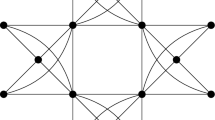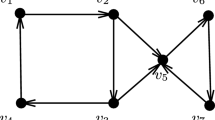Abstract
The problem of counting the number of spanning trees is an old topic in graph theory with important applications to reliable network design. Usually, it is desirable to put forward a formula of the number of spanning trees for various graphs, which is not only interesting in its own right but also in practice. Since some large graphs can be composed of some existing smaller graphs by using the product of graphs, the number of spanning trees of such large graph is also closely related to that of the corresponding smaller ones. In this article, we establish a formula for the number of spanning trees in the lexicographic product of two graphs, in which one graph is an arbitrary graph G and the other is a complete multipartite graph. The results extend some of the previous work, which is closely related to the number of vertices and Lapalacian eigenvalues of smaller graphs only.
Similar content being viewed by others
References
Cayley A. A theorem on trees. Quart J Math, 1889, 23: 276–278
Ho J, Hwang W. Wavelet Bayesian network image denoising. IEEE Trans Image Process, 2013, 22: 1277–1290
Ou W H, You X G, Cheung Y M, et al. Structured sparse coding for image representation based on L1-graph. ICPR, 2012: 3220–3223
Gonzalez J, Low Y, Guestrin C. Parallel splash belief propagation. J Mach Learn Res, 2009, 1: 1–48
Cheng C. Maximizing the total number spanning trees in a graph: two related problems in graph theory and optimization design theory. J Combin Theory B, 1981, 31: 240–248
Li B L, Zhang S G. Heavy cycles and spanning trees with few leaves in weighted graphs. Appl Math Lett, 2011, 24: 908–910
Huang Z, Li X. On the number of spanning trees of some composite graphs (in Chinese). Acta Math Sci, 1995, 15: 259–268
Li X, Huang Z. On the Number of Spanning Trees of Graphs and Applications of Networks. Harbin: Harbin Institute of Technology Press, 1999
Zhang Y, Yong X, Golin M J. The number of spanning trees in circulant graphs. Discrete Appl Math, 2000, 223: 337–350
Biggs N. Algebraic Graph Theory. 2nd ed. Cambridge: Cambridge University Press, 1993
Boesch F, Prodinger H. Spanning tree formulas and Chebyshev polynomials. Graph Combinator, 1986, 2: 191–200
Boesch F, Wang J F. A conjecture on the number of spanning trees in the square of a cycle. In: Notes from New York Graph Theory Day V. New York: New York Academy Sciences, 1982. 1–16
Chung K L, Yan W M. On the number of spanning trees of a multi-complete/star related graphs. Inform Process Lett, 2000, 76: 113–119
Gilbert B, Kelman A K. Laplacian spectra and spanning trees of threshold graphs. Discrete Math, 1996, 65: 255–273
Imrich W, Izbicki H. Associative products of graphs. Monatsh Math, 1975, 80: 277–281
Zhang Z, Zhu Y F. Cyclic arc-connectivity in a Cartesian product digraph. Appl Math Lett, 2010, 23: 796–800
Li F, Peng Y, Zhao H X. On the number of spanning trees of the multi-lexicographic product of networks (in Chinese). Software, 2011, 7: 51–53
Li F, Xu Z B, Zhao H X, et al. On the number of spanning trees of the lexicographic product of networks. Scientia Sin Inform, 2012, 42: 949–959
Li F, Wang W, Xu Z B, et al. Some results on the lexicographic product of vertex-transitive graphs. Appl Math Lett, 2011, 24: 1924–1926
Yegnanarayanan V, Thiripurasundari P R. On some graph operations and related applications. Electron Notes Discrete Math, 2009, 33: 123–130
Moon J. Enumerating Labelled Trees, Graph Theory and Theoretical Physics. New York: New York Academic Press, 1967. 261–272
Kelman A K, Chelnokov V M. A certain polynomials of a graph and graphs with an extremal number of trees. J Combin Theory B, 1974, 16: 197–214
Wang W, Li F, Lu H L, et al. Graphs determined by their generalized characteristic polynomials. Linear Algebra Appl, 2011, 434: 1378–1387
Author information
Authors and Affiliations
Corresponding author
Rights and permissions
About this article
Cite this article
Liang, D., Li, F. & Xu, Z. The number of spanning trees in a new lexicographic product of graphs. Sci. China Inf. Sci. 57, 1–9 (2014). https://doi.org/10.1007/s11432-014-5110-z
Received:
Accepted:
Published:
Issue Date:
DOI: https://doi.org/10.1007/s11432-014-5110-z




